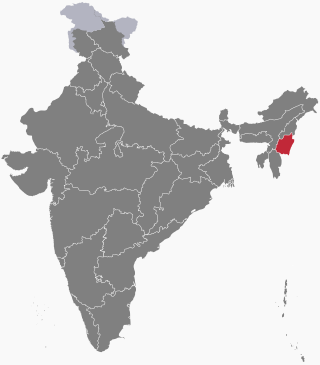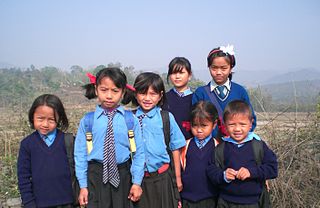
Manipur is a state in northeast India, with the city of Imphal as its capital. It is bounded by the Indian states of Nagaland to the north, Mizoram to the south and Assam to the west. It also borders two regions of Myanmar, Sagaing Region to the east and Chin State to the south. The state covers an area of 22,327 km2 (8,621 sq mi). The official and most widely spoken language is the Meitei language. Native to the Meitei people, it is also used as a lingua franca by smaller communities, who speak a variety of other Tibeto-Burman languages. Manipur has been at the crossroads of Asian economic and cultural exchange for more than 2,500 years. This exchange connects the Indian subcontinent and Central Asia to Southeast Asia, East Asia, Siberia, regions in the Arctic, Micronesia and Polynesia enabling migration of people, cultures and religions.
The Paite people are an ethnic group in Northeast India, mainly living in Manipur and Mizoram. The Paites are recognized as a scheduled tribe in these two states. They are part of the larger Zo people, but also use their Zomi identity along with all the 7 tribes under 'Zomi Council' . "Guite" is a major clan of the Paite people.

The Kuki people, or Kuki-Zo people, are an ethnic group in the Northeastern Indian states of Manipur, Nagaland, Assam, Meghalaya, Tripura and Mizoram, as well as the neighbouring countries of Bangladesh and Myanmar. The Kukis form one of the largest hill tribe communities in this region. In Northeast India, they are present in all states except Arunachal Pradesh. The Chin people of Myanmar and the Mizo people of Mizoram are kindred tribes of the Kukis. Collectively, they are termed the Zo people.
Moreh is a border town located on the India–Myanmar border in Tengnoupal district of the Indian state of Manipur. As a rapidly developing international trade point with the integrated customs and international immigration checkpoint, Moreh plays an important role in India's Look East Policy, trade and commerce under ASEAN–India Free Trade Area, India-Myanmar relationship, India–Myanmar–Thailand road connectivity, and Trans-Asian Railway connectivity.
The Kuki-Chin–Naga languages are a geographic clustering of languages of the Sino-Tibetan family in James Matisoff's classification used by Ethnologue, which groups it under the non-monophyletic "Tibeto-Burman". Their genealogical relationship both to each other and to the rest of Sino-Tibetan is unresolved, but Matisoff lumps them together as a convenience pending further research.
Thadou, Kuki, or Thado Chin is a Sino-Tibetan language of the Northern Kuki-Chin sub-branch. It is spoken by the Thadou people in Northeast India. The speakers of this language use Meitei language as their second language (L2) according to the Ethnologue.

The Aimol people are an ethnic group living mainly in Manipur and in parts of Mizoram, Tripura, Nagaland and Assam,Meghalaya in India. They speak Aimol language which is a Kuki-Chin language. They identify themselves as 'Aimol' an independent tribe with no affiliates. Aimols have continued to live in harmony with neighboring communities before the independence and to this day. Aimols are closely related to Kom, Koireng, Chiru, Chothe,khelma,Biete,Biate etc. They use Meitei language as their second language (L2) according to the Ethnologue.
The Sal languages, also known as the Brahmaputran languages, are a branch of Tibeto-Burman languages spoken in northeast India, as well as parts of Bangladesh, Myanmar (Burma), and China.
The Kuki-Chin languages are a branch of the Sino-Tibetan language family spoken in northeastern India, western Myanmar and southeastern Bangladesh. Most notable Kuki-Chin-speaking ethnic groups are referred to collectively as the Zo people which includes: the Mizo of Mizoram, the Kuki of Manipur, Assam, Nagaland, Tripura and Bangladesh and the Chin of Chin State, Myanmar.
The Kuki–Paite Conflict, also called Kuki–Zomi Conflict, was an ethnic conflict during 1997–1998 between tribal communities in Churachandpur district in Manipur, India. The conflict started when a Kuki insurgent group, KNF, mercilessly killed 10 Paite villagers of Saikul Village on June 24, 1997, which led to pitting one group that subscribed to the Kuki label against another group that subscribed to the Zomi label, the latter being led by the Paites. The conflict lasted for over a year, during which 352 people died, thousands of homes were destroyed and over 13,000 people were displaced. The Government of India sent in the Indian Army to attempt to stop the violence, but peace was restored in September–October 1998 only with the initiative of the Church.

The Tibeto-Burman languages are the non-Sinitic members of the Sino-Tibetan language family, over 400 of which are spoken throughout the Southeast Asian Massif ("Zomia") as well as parts of East Asia and South Asia. Around 60 million people speak Tibeto-Burman languages. The name derives from the most widely spoken of these languages, Burmese and the Tibetic languages, which also have extensive literary traditions, dating from the 12th and 7th centuries respectively. Most of the other languages are spoken by much smaller communities, and many of them have not been described in detail.
Bawm or Bawm Zo, also known as Banjogi, is a Kuki-Chin language primarily spoken in Bangladesh. It is also spoken in adjacent regions of Northeast India and Myanmar. The Bawms that live on the Chittagong Hill Tracts of Bangladesh call their settlements "Bawmram", which literally means an area or location inhabited by Bawms.

Sadar Hills is a geographic area in the state of Manipur in North East India.

The Insurgency in Manipur is an ongoing armed conflict between India and a number of separatist rebel groups, taking place in the state of Manipur. The Insurgency in Manipur is part of the wider Insurgency in Northeast India; it displays elements of a national liberation war as well as an ethnic conflict.
The Northwestern Kuki-Chin languages, originally called Old Kuki languages, is a branch of Kuki-Chin languages.

The hill tribes of Northeast India are hill people, mostly classified as Scheduled Tribes (STs), who live in the Northeast India region. This region has the largest proportion of scheduled tribes in the country.
Manipur State Constitution Act 1947 is an act which enabled the princely state of Manipur to have a de jure written constitution enacted by the last Maharajah of Manipur, Bodhchandra Singh. Under the constitution, a Legislative Assembly was elected in mid-1948 and a ministry was formed, which was responsible to the Maharaja. The constitution is deemed to have lapsed on 15 October 1949, when the Maharaja signed a merger agreement with the Indian Union. The validity of the act in present time is debated.
The Kuki Rebellion or Anglo-Kuki War, was one of the major tribal revolts during the British colonial rule in India. It was a rebellion by the Kuki tribes of Manipur, ostensibly to resist their forcible recruitment into labour corps for the First World War. From a wider historical perspective, it can also be read as a response to the colonial intrusion into Kuki livelihoods, with new forms of economic relations and land policies, as well as the declining authority of Kuki chiefs. The British suppressed the rebellion after two years of fighting, burning 126 villages, destruction of food-stocks, and killing and maiming many of the Kuki community. During 2017–2019, the Kuki community of Manipur arranged centennial commemorations for the event at multiple locations in Manipur. Their celebration of the event as a "war" came into contestation by the Meitei and Naga communities of Manipur.
In the state of Manipur in northeast India, conflict arose between the Kukis and Nagas soon after India's independence. The Nagas, who dominated the northern hill regions of the state, attempted to homogenise the area in order to demand integration with the Naga Hills region further north. This caused displacement of Kukis to the southern districts as well as the central hill regions during the 1950s. Major clashes again occurred during 1992-98, leading to the deaths of more than 1,000 people and diplacement of 50,000–100,000 people.

Prostitution is practised by some people in the Kuki society. Kuki tribes live mainly concentrated in Myanmar's Chin State, Bangladesh's Chittagong Hill Tracts and Northeast India, mainly in Manipur and Mizoram.









